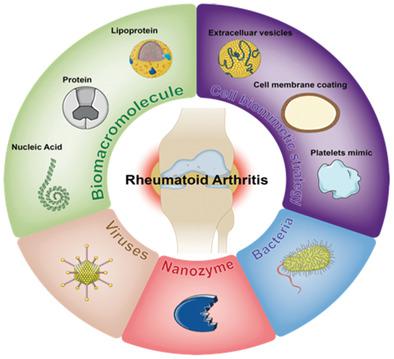当前位置:
X-MOL 学术
›
Adv. Funct. Mater.
›
论文详情
Our official English website, www.x-mol.net, welcomes your
feedback! (Note: you will need to create a separate account there.)
Biomimetic and Bioinspired Intervention Strategies for the Treatment of Rheumatoid Arthritis
Advanced Functional Materials ( IF 18.5 ) Pub Date : 2021-07-08 , DOI: 10.1002/adfm.202104640 Yu Han 1 , Xin Pang 1, 2 , Guofu Pi 1
Advanced Functional Materials ( IF 18.5 ) Pub Date : 2021-07-08 , DOI: 10.1002/adfm.202104640 Yu Han 1 , Xin Pang 1, 2 , Guofu Pi 1
Affiliation

|
Rheumatoid arthritis (RA) affects the joints and extra-articular organs and poses a significant health care problem in the modern era. Although current standard treatment modalities successfully control RA flares, no curative treatment modality for RA has been developed. Nanomedicines have addressed the drug side effects and limited efficacy of RA treatment. However, synthetic nanoparticles (NPs) can be toxic and induce immune responses in vivo, posing a risk of further RA progression. Biomimetic nanodrug delivery systems have the potential to improve the biocompatibility of synthetic NPs and the stability and targeting of pharmaceuticals in vivo. For many immune-related diseases with a complex pathogenesis and that involve a large number of different cell types, biomimetic nanodelivery systems can reduce the immunogenicity of NPs. Furthermore, some bioinspired strategies can mimic certain components of the pathological process, allowing for a more precise drug delivery and effective disease control via the carriers. This article highlights recent research on biomimetic nanodelivery systems for the treatment of RA and categorizes the design methodologies for various targets and carriers.
中文翻译:

治疗类风湿性关节炎的仿生和仿生干预策略
类风湿性关节炎 (RA) 会影响关节和关节外器官,并在现代造成重大的医疗保健问题。尽管当前的标准治疗方式成功地控制了 RA 发作,但尚未开发出治疗 RA 的治疗方式。纳米药物已经解决了 RA 治疗的药物副作用和有限的疗效。然而,合成纳米粒子 (NPs) 可能有毒并在体内诱导免疫反应,从而构成进一步发展 RA 的风险。仿生纳米药物递送系统有可能提高合成纳米颗粒的生物相容性以及体内药物的稳定性和靶向性。对于许多发病机制复杂且涉及大量不同细胞类型的免疫相关疾病,仿生纳米递送系统可以降低纳米颗粒的免疫原性。此外,一些仿生策略可以模拟病理过程的某些组成部分,从而通过载体实现更精确的药物输送和有效的疾病控制。本文重点介绍了用于治疗 RA 的仿生纳米递送系统的最新研究,并对各种目标和载体的设计方法进行了分类。
更新日期:2021-09-16
中文翻译:

治疗类风湿性关节炎的仿生和仿生干预策略
类风湿性关节炎 (RA) 会影响关节和关节外器官,并在现代造成重大的医疗保健问题。尽管当前的标准治疗方式成功地控制了 RA 发作,但尚未开发出治疗 RA 的治疗方式。纳米药物已经解决了 RA 治疗的药物副作用和有限的疗效。然而,合成纳米粒子 (NPs) 可能有毒并在体内诱导免疫反应,从而构成进一步发展 RA 的风险。仿生纳米药物递送系统有可能提高合成纳米颗粒的生物相容性以及体内药物的稳定性和靶向性。对于许多发病机制复杂且涉及大量不同细胞类型的免疫相关疾病,仿生纳米递送系统可以降低纳米颗粒的免疫原性。此外,一些仿生策略可以模拟病理过程的某些组成部分,从而通过载体实现更精确的药物输送和有效的疾病控制。本文重点介绍了用于治疗 RA 的仿生纳米递送系统的最新研究,并对各种目标和载体的设计方法进行了分类。











































 京公网安备 11010802027423号
京公网安备 11010802027423号